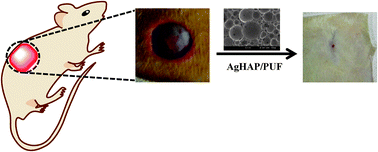Evaluation of AgHAP-containing polyurethane foam dressing for wound healing: synthesis, characterization, in vitro and in vivo studies†
Abstract
Silver-containing dressings have been widely used to control wound infection. In this study, we developed various amounts of silver-hydroxyapatite (AgHAP)-containing polyurethane foams (PUFs) (AgHAP–PUFs), and their biological properties including biocompatibility, antibacterial activities, and in vivo wound healing properties were evaluated in the Sprague-Dawley rat model. From electron microscopy imaging, it was found that AgHAP particles are uniformly dispersed inside PUFs. The release of Ag from PUFs was dependent on both time and concentration, i.e., the amount of released Ag was significantly higher with increasing immersion time and Ag content in the PUFs. From the cytotoxicity test, AgHAP–PUFs exhibited high antibacterial efficacy against four pathogenic bacteria, and they were not cytotoxic against L-929 fibroblast cells. AgHAP–PUF treated groups exhibited scar-free wound healing by promoting re-epithelialization and collagen deposition in the infected excision wound model. Overall, it is evident that AgHAP–PUFs may be considered as a good antibacterial wound dressing for infected wounds due to their good antibacterial activity, biocompatibility, and wound healing rate.


 Please wait while we load your content...
Please wait while we load your content...